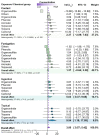Research Trends, Biases, and Gaps in Phytochemicals as Insecticides: Literature Survey and Meta-Analysis
- PMID: 36679031
- PMCID: PMC9866902
- DOI: 10.3390/plants12020318
Research Trends, Biases, and Gaps in Phytochemicals as Insecticides: Literature Survey and Meta-Analysis
Abstract
A 76-year literature survey and meta-analyses were carried out to recognize the trends, biases, and knowledge gaps of studies focusing on major groups of compounds of botanical origin, or phytochemicals, as insecticides. The survey found that the main phytochemicals prospected as insecticides belong to the following major chemical groups: terpenoids, terpenes, and carbonyl, all of which were tested, mainly against beetles (Coleoptera), caterpillars (i.e., larvae of Lepidoptera), and mosquitoes and other flies (i.e., Diptera). These studies are burgeoning at an exponential rate, with an evident focus on mortality endpoint estimates, but they are also neglecting sublethal assessments. China and India in Asia, as well as Brazil in the Americas, were responsible for most studies. The majority of the papers used stored grain insects as experimental models, which limits the applicability and representativeness of the findings. As a result, the main modes of exposure tested were fumigation and contact, which leads to the prevalence of estimates of lethal concentration in these studies. Therefore, a broader range of insect species deserves testing, with suitable modes of exposure identifying and characterizing the main molecules responsible for the insecticidal activity, which is seldom performed. Attention to these needs will circumvent current biases and allow the recognition of the main patterns of association between the origin and structure of phytochemicals and their insecticidal effects.
Keywords: arthropods; bioinsecticides; botanical insecticides; insect pest management; natural products; pest control.
Conflict of interest statement
The authors declare no conflict of interest.
Figures









References
-
- Hairston N.G., Smith F.E., Slobodkin L.B. Community Structure, Population Control, and Competition. Am. Nat. 1960;94:421–425. doi: 10.1086/282146. - DOI
-
- Murdoch W.W. Community Structure, Population Control, and Competition-A Critique. Am. Nat. 1966;100:219–226. doi: 10.1086/282415. - DOI
-
- Power M.E. Top-Down and Bottom-Up Forces in Food Webs: Do Plants Have. Ecology. 1992;73:733–746. doi: 10.2307/1940153. - DOI
-
- Wilkinson D.M., Sherratt T.N. Why Is the World Green? The Interactions of Top–down and Bottom–up Processes in Terrestrial Vegetation Ecology. Plant Ecol. Divers. 2016;9:127–140. doi: 10.1080/17550874.2016.1178353. - DOI
-
- Sharma G., Malthankar P.A., Mathur V. Insect-Plant Interactions: A Multilayered Relationship. Ann. Entomol. Soc. Am. 2021;114:1–16. doi: 10.1093/aesa/saaa032. - DOI
Grants and funding
LinkOut - more resources
Full Text Sources
Research Materials

